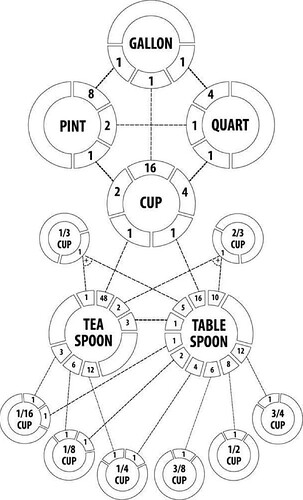This is the most accurate reasoning: https://youtu.be/p35-geJSJG4?si=eYhPofKoKczgnRFe
In America, most people have this handy chart hanging in the kitchen. It takes all of the guesswork out of measurements.
Does not play for me , I’m in Sweden…
And a uk gallon is lager than a U.S. one, 160oz versus 128oz. However the pints to gallons ratio is the same at 8:1 therefore our pint is also larger. The Imperial pint contains 20 British fluid oz equal to 28.413 ml each. The American pint, by contrast, contains 16 US fluid oz equal to 29.574 ml each . This makes the US fluid ounce 4% larger than the Imperial one. The Imperial pint is approximately 20% larger than the US pint.
Therefore the flow chart is of little use to UK imperial measures. Shame.
Oh, right. IIRC, when my oldest sister lived in Toronto for a year or so around 1980, she said her car’s odometer was in kilometers but gasoline (petrol?) was still sold in imperial gallons, so she had no clue what kind of “gas mileage” she was getting.
This short informational video should clear it up … https://youtu.be/BtKbq_zAr-A?si=aJ2WRQXy5wrqI7da
As a European I love the way the comma moves in the metric system. It‘s just so „neat“. But the other day I got into a camp fire discussion about the „ten“ part of the metric system and my mind got blown to bits. Guy said - well - ten is arbitrary, too. Could be nine, could be 14 - doesn‘t matter. You just need unique signs. 10 might just feels right because we have ten fingers. ![]()
So yeah: 3,14159… as Pi might not make any sense to an Alien because the digit shifts would look completely different in their digit-system. ![]()
Gee and I thought it was an eye chart…
